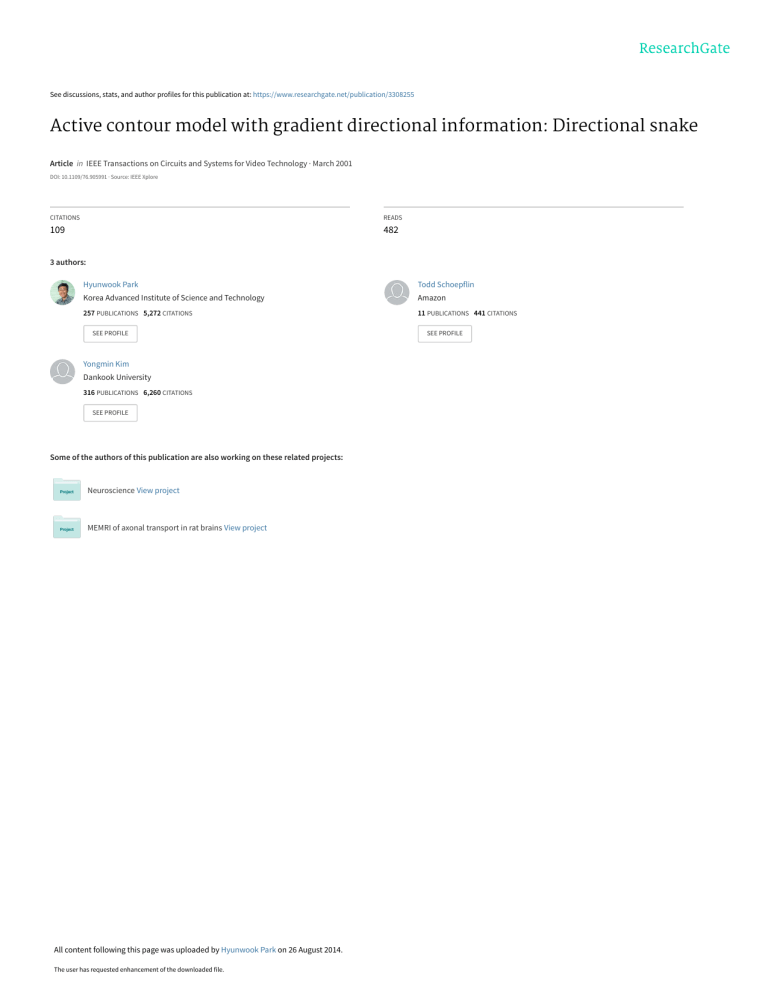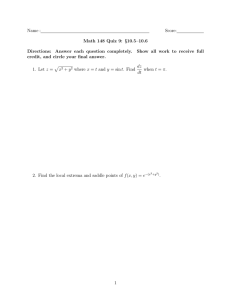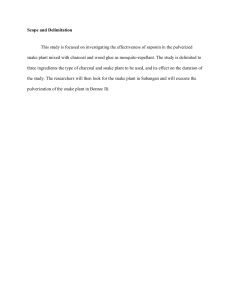Directional Snake: Active Contour Model for Image Segmentation
advertisement

See discussions, stats, and author profiles for this publication at: https://www.researchgate.net/publication/3308255 Active contour model with gradient directional information: Directional snake Article in IEEE Transactions on Circuits and Systems for Video Technology · March 2001 DOI: 10.1109/76.905991 · Source: IEEE Xplore CITATIONS READS 109 482 3 authors: Hyunwook Park Todd Schoepflin Korea Advanced Institute of Science and Technology Amazon 257 PUBLICATIONS 5,272 CITATIONS 11 PUBLICATIONS 441 CITATIONS SEE PROFILE Yongmin Kim Dankook University 316 PUBLICATIONS 6,260 CITATIONS SEE PROFILE Some of the authors of this publication are also working on these related projects: Neuroscience View project MEMRI of axonal transport in rat brains View project All content following this page was uploaded by Hyunwook Park on 26 August 2014. The user has requested enhancement of the downloaded file. SEE PROFILE 252 IEEE TRANSACTIONS ON CIRCUITS AND SYSTEMS FOR VIDEO TECHNOLOGY, VOL. 11, NO. 2, FEBRUARY 2001 Active Contour Model with Gradient Directional Information: Directional Snake HyunWook Park, Todd Schoepflin, and Yongmin Kim Abstract—Active contours or snakes are an effective edge-based method in segmenting an object of interest. However, the segmented boundary of a moving object in one video frame may lie far from the same moving object in the next frame due to its rapid motion, causing the snake to converge on the wrong edges. To guide the snake toward the appropriate edges, we have added gradient-directional information to the external image force to create a “directional snake.” Thus, in minimizing the snake energy, the new method considers both the gradient strength and gradient direction of the image. Experimental results demonstrate that the directional snake can provide a better segmentation than the conventional method in certain situations, e.g., when there are multiple edge candidates in the neighborhood with different directions. The directional snake is significant because it provides a framework to incorporate directional information in digital video segmentation. results with the directional snake on a synthesized image and a real video sequence are presented in Section IV. Finally, conclusions are given in Section V. II. ACTIVE CONTOUR MODELS Active contour models are the energy-minimizing spline guided by internal constraint forces and influenced by external image forces that pull it toward features like lines and edges [3]. The conventional energy function in the snake is defined in discrete form as follows: (1) Index Terms—Active contour, directional snake, image gradient, segmentation, video tracking. I. INTRODUCTION I MAGE segmentation is an important research topic for many areas, e.g., military, medical, and digital video applications. Recently, researchers have developed various algorithms for image and video segmentation [1], [2]. Among these algorithms, active contour models, more widely known as snakes, have been extensively used as an edge-based segmentation method [3]–[5]. The snake is an energy-minimizing spline guided by external image and internal spline forces. In general, edge information is used as an external image force, which is usually represented by the gradient magnitude of an image. The snake is attracted to contours with large image gradients, i.e., strong edges. However, when an image has a complex background, the snake gets confused, and finding the correct object boundary from the gradient magnitude only is not easy. In order to improve the effectiveness of the snake, we have improved the active contour models by including gradient direction information in the external image force. This additional information helps the snake get attracted to the correct boundary edges. Section II describes the conventional active contour model and its implementation using the gradient-descent method. The developed directional snake and its application to video segmentation and tracking are introduced in Section III. Experimental Manuscript received September 17, 1999; revised June 16, 2000. This paper was recommended by Associate Editor K. Aizawa. H. Park is with the Department of Electrical Engineering, Korea Advanced Institute of Science and Technology, Yusong-gu Taejon 305-701, Korea (e-mail: hwpark@athena.kaist.ac.kr). T. Schoepflin and Y. Kim are with the Image Computing Systems Laboratory, Department of Electrical Engineering, University of Washington, Seattle, WA 98195 USA. Publisher Item Identifier S 1051-8215(01)01250-2. and are the internal spline energy and the where external image energy at the th position of the contour (called snaxel ), respectively, which can be defined as (2) (3) is the original pixel value at . In (1), is the where number of snaxels, and the order of sequencing snaxels is counterclockwise along the closed contour. The weighting factors in and , are defined to control the relative importance of (2), the membrane and thin-plate terms for the th snaxel, respectively, and is the 2-D coordinates of the th snaxel, and . The external energy is set to be the negative magnitude of the image gradient as given in (3), so that the snake is attracted to the regions with low external energy, i.e., strong edges. The optimum locations of the snaxels are searched so that the can be minimized. There are many ways to snake energy obtain new snaxel positions with lower snake energy, e.g., gradient-descent methods [3] and dynamic programming methods [4], [5]. The gradient-descent method attempts to minimize the snake energy by finding new snaxel positions iteratively (4) where is a pentadiagonal matrix containing the numerical co, efficients for descending the gradient of the internal energy 1051–8215/01$10.00 © 2001 IEEE IEEE TRANSACTIONS ON CIRCUITS AND SYSTEMS FOR VIDEO TECHNOLOGY, VOL. 11, NO. 2, FEBRUARY 2001 253 is a step size, and column vectors of and are given as at time at time at time at time where Fig. 1. An example of the conventional snake. (a) Black and white test image. (b) The initial contour overlaid on the gradient magnitude image. (c) The snake result overlaid on the gradient magnitude image. denotes the transpose of the vector . In (4), is an identity matrix. Equation (4) is iterated, producing a local minimum for the snake energy. As shown in these equations, the external energy is defined from the magnitude of the gradient image. When the gradient magnitude is computed, the directional information of the gradient can be easily obtained. This additional information can be used in improving the segmentation performance of the active contour model. III. DIRECTIONAL SNAKE The gradient image can be obtained by applying any gradient operator, e.g., Sobel, Prewitt, and derivative of Gaussian (DOG). An image is convolved with a gradient operator, which typically consists of horizontal and vertical gradient kernels. In this case, and direction are the gradient magnitude obtained from a 2-D image as follows: (5) (6) where Fig. 2. Block diagram of video segmentation and tracking using the directional snake. where denotes a 2-D convolution operation and and are the horizontal and vertical gradient kernels, respectively. In the conventional snake as defined in (1)–(3), only the gradient magnitude contributes to the snake energy. Thus, the snake may be attracted to a strong edge that has a different gradient direction from the correct boundary. Fig. 1 illustrates this limitation of the conventional magnitude-only snake. A black and white image is given in Fig. 1(a), and a manually-defined initial contour and the snake result for the image are overlaid on the gradient magnitude image in Fig. 1(b) and (c), respectively. The DOG kernel. As gradient image is obtained by applying a 254 IEEE TRANSACTIONS ON CIRCUITS AND SYSTEMS FOR VIDEO TECHNOLOGY, VOL. 11, NO. 2, FEBRUARY 2001 Fig. 3. Segmented contours from the directional snake with the initial contour in Fig. 1(b) and the directional parameters ( ) of: (a) 1 and (b) are overlaid on the gradient magnitude image. shown in Fig. 1(c), the conventional snake fails to converge to either the outer or inner boundary. However, using the gradient direction could help the snake to converge on either the outer or inner boundary rather than lying partly on both contours. In order to consider the directional information of the gradient, the external energy of the image is redefined as follows: 01. The contours parameters are defined from the contour of the previous frame as follows: if otherwise for if (7) otherwise is the contour’s normal direction at the th snaxel where as follows: (8) is the counterclockwise contour direction at and where is a directional parameter for the th snaxel defined as 1 or 1 according to the predefined gradient direction of the contour. can be obtained as follows: (9) and are the 2-D cowhere and , respectively. If we ordinates of the snaxels want the gradient direction at to be inward, is 1. Otherwise, is 1. When the contour normal direction is opposite to the gradient direction, the external energy is maximum, i.e., zero according to (7). In this case, the developed directional snake does not get attracted to the edges with an opposite direction to the gradient direction. Thus, only the edges with a correct gradient direction participate in the snake minimization process of (4). Fig. 2 shows the block diagram of a tracking algorithm using the directional snake. Since it uses information from a previous contour, the directional snake is best applied in the context of video segmentation and tracking. In Fig. 2, the directional (10) th frame are Therefore, the directional parameters for the and the gradient direction derived from the contour direction of the th frame as given in (10). The directional parameters and the th frame contour are used as the initial dith frame. rectional contour for the segmentation of the IV. EXPERIMENTAL RESULTS AND DISCUSSIONS The proposed directional snake was applied to the black and white image in Fig. 1(a). The segmentation result depends on the predefined directional parameters. Fig. 3(a) and 3(b) are the segmentation results with the directional parameter of 1 and 1 for all snaxels, respectively. When the directional parameter is 1, the directional snake makes the contour converge toward the boundary edges with an inward gradient direction, i.e., the gradient direction is the left-hand side of the contour’s counterclockwise direction. On the other hand, the contour moves toward boundary edges with an outward gradient direction when the directional parameter is 1. In this experiment, the directional parameters for all the snaxels in the contour are the same. However, different directional parameters could be assigned to different snaxels along a contour. In this case, the snaxels with the directional parameters of 1 converge onto the inside edges, and the snaxels with the directional parameters of 1 converge onto the outside edges. Thus, we need to know the directional parameters for all snaxels of an initial contour. This prior knowledge on the directional parameters may not be realizable in segmenting a single frame because it is unrealistic to define the directional parameters manually. In video segmentation and tracking, however, we can utilize the initial contour and its directional parameters from the segmentation result of the previous frame. IEEE TRANSACTIONS ON CIRCUITS AND SYSTEMS FOR VIDEO TECHNOLOGY, VOL. 11, NO. 2, FEBRUARY 2001 255 Fig. 4. Three consecutive frames of a video sequence and the segmentation results. (a) First frame. (b) Second frame. (c) Third frame. (d) Initial contour obtained from the first frame. (e) Segmentation result of the second frame with the conventional snake. (f) Segmentation result of the third frame with the conventional snake. (g) Segmentation result of the second frame with the directional snake. (h) Segmentation result of the third frame with the directional snake. The directional snake has been applied to video segmentation and tracking for MPEG-4 encoding with the algorithm shown in Fig. 2. In Fig. 4, the major moving part is the woman’s left arm. Since the initial contour from the previous frame intersects with the adjacent boundary of her left arm in the current frame, the conventional snake fails to find the correct contour around the left arm [Fig. 4(e) and (f)]. In contrast, Fig. 4(g) and (h) show that the directional snake is able to correctly follow the woman’s arm for several frames. However, a drawback of the directional snake is the segmentation result could be degraded and the wrong segmentation could be propagated to next frame segmentation if the directional parameters are distorted by noise or uncertain object boundaries, since the directional parameters have been determined from the segmented contour of the previous frame. This means that the directional parameters of the previous frame could be different from those of the current frame, thus potentially resulting in an inaccurate segmentation. In addition, the directional snake with edge-based energy function has a limitation for application to heavily textured area, since the textured area has many edges near object boundary. However, directional information of the directional snake can improve the segmentation accuracy of textured area in comparison with the conventional snake as shown in the woman’s hair area in Fig. 4. V. CONCLUSION We have developed an active contour model, named the directional snake, which uses information about not only the gradient magnitude but also direction. By incorporating the directional information, our approach provides better segmentation results than the conventional snake when the initial contour intersects 256 IEEE TRANSACTIONS ON CIRCUITS AND SYSTEMS FOR VIDEO TECHNOLOGY, VOL. 11, NO. 2, FEBRUARY 2001 adjacent object boundaries in the subsequent frames. In addition, the directional snake can be used for automatically tracking an object because the directional parameters of the contour can be obtained from the segmentation result of the previous frame. Researchers have recognized the availability of gradient direction information, but have not incorporated it into their snake algorithms. Thus, our algorithm represents a significant first step in developing various ways using directional information to improve the edge-based segmentation methods. REFERENCES [1] T. Meier and K. N. Ngan, “Automatic segmentation of moving objects for video object plane generation,” IEEE Trans. Circuits Syst. Video Technol., vol. 8, pp. 525–538, 1998. View publication stats [2] C. Gu and M. C. Lee, “Semiautomatic segmentation and tracking of semantic video object,” IEEE Trans. Circuits Syst. Video Technol., vol. 8, pp. 571–584, 1998. [3] M. Kass, A. Witkin, and D. Terzopoulos, “Snakes: Active contour models,” Int. J. Comput. Vis., vol. 1, pp. 321–331, 1988. [4] A. Amini, T. Weymouth, and R. Jain, “Using dynamic programming for solving variational problems in vision,” IEEE Trans. Pattern Anal. Machine Intell., vol. 12, pp. 855–867, 1990. [5] S. Sun and Y. Kim, “Active contour with global relaxation in video object segmentation and tracking,” UWICSL Invention Disclosure, Sept. 1, 1998.


